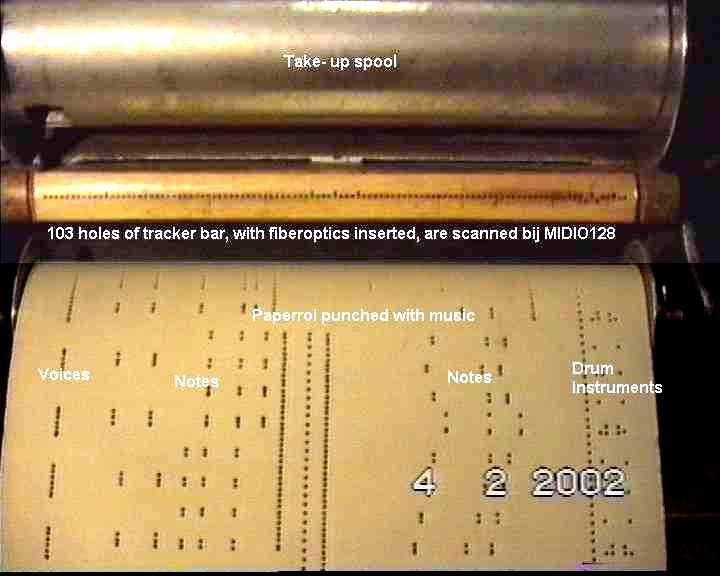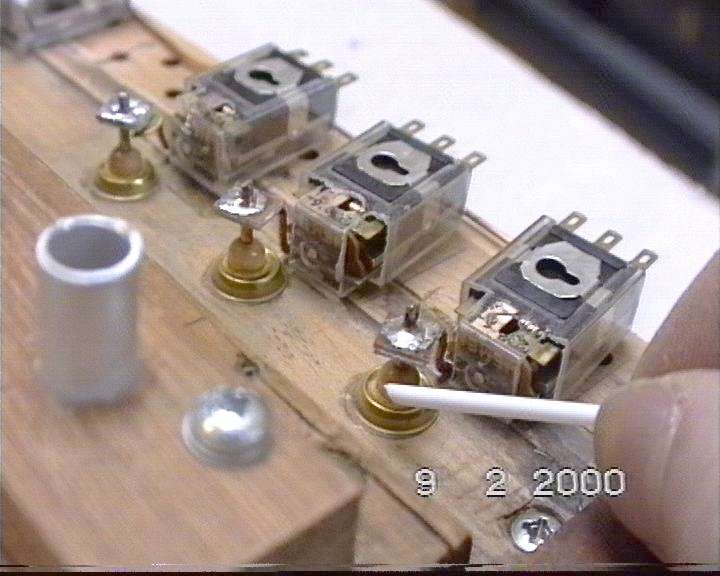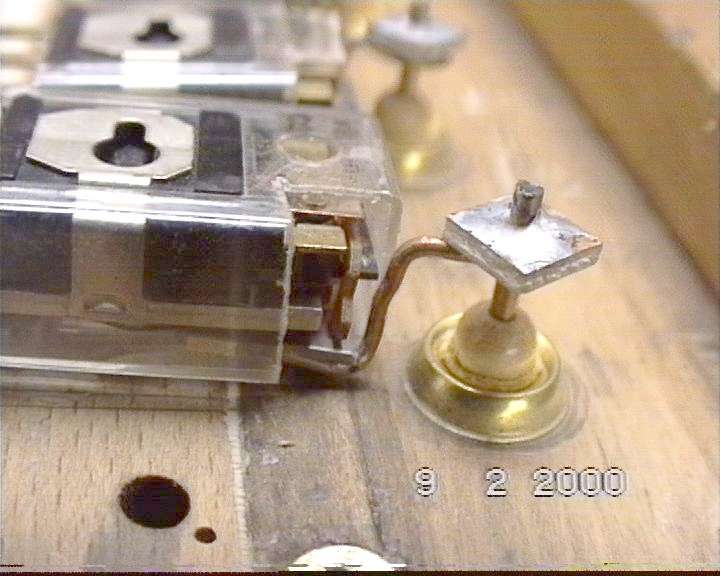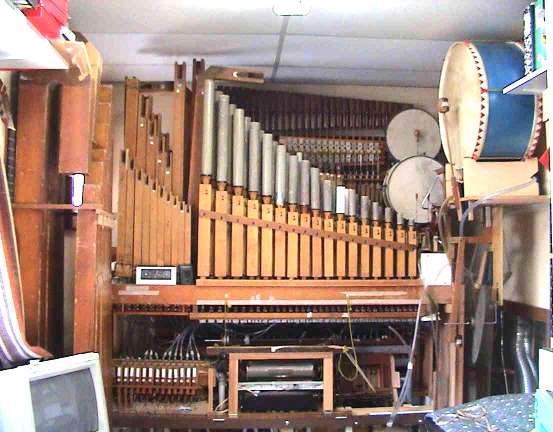| You Are Not Logged In | Login/Get New Account |
|
Please Log In. Accounts are free!
Logged In users are granted additional features including a more current version of the Archives and a simplified process for submitting articles. |
|
MMD
 Tech
Tech
 mvdReijden
mvdReijden
|
|
by Willy van der Reijden (020312 MMDigest)
When I started the restoration of the Frati, about six years ago, I inserted fiber optics in the existing holes of the wooden tracker bar. On the bottom side of the tracker bar, where the holes are zigzagged in four rows, I inserted phototransistors. These receive light from a 50 cm long lamp, mounted in front of the tracker bar, when punched holes in the paper roll pass by. The phototransistors actuate inexpensive surplus 24-volt relays by means
of a simple electronic circuit and type ULN relay driver ICs (7 in one
package, including 'free wheel' snubber diodes :)).
All this was done with no MIDI in mind but merely of time, to get the orchestrion playing as fast as possible in order to let the 93-year-old lady, who once owned the Frati, hear the result, and this was realised last summer. (Designing electronic circuits was my daily bread for more than 30 years.) Pleased with the results so far, later on the idea of MIDIfying came up. Searching with Google.com I came across the "Do it Yourself" MIDI web site of Thorsten Klose, and I mailed him about my Frati and MIDIfying it. Thorsten was so kind to help me realize this. He designed the Midio128 for this purpose, just for free. That is, he wrote the program and burned the PIC for me. I designed and made the PCB in my home shop. See the results at http://www.ucapps.de/midio128.html
Click on fratipcb.jpg
on the bottom of this page to see my homemade PCB. I know it doesn't
look nice but it works.
All these programs are free available on the net. Thorsten Klose explains this on his site in more detail. You don't need to learn to write a program; I cannot either. You're just typing the *.ini file as I type this mail right now. The only thing you need is to know the hexadecimal codes that are used for the MIDI events. As an example: The sustain pedal of the Frati is hole 12 of the tracker bar. So I assigned the Hex code of the sustain pedal, being B0 40, to pin 12 which happens to be also pin 12 of the PCB ;) So when recording a roll, every time the sustain pedal is activated, you see the well-known Pedal symbol in the scores of Cakewalk or whatever sequencing program you use and of course also the note's that are played. So what are the possibilities of this MIDI interface? 1. First of all I can play/scan my rolls and record them in MIDI format to archive them. 2. I can play the recorded MIDI file and you will hear the roll playing without being there. 3. If I could borrow some of the 200+ Frati rolls at a museum in Berlin they could also be archived. 4. Other compositions in MIDI file format can be played. 5. By attaching a MIDI keyboard to the MIDI interface one can play the orchestrion live, along with an accompanying rhythm and voice changes, and record this happening for later use. (There is still a minor imperfection of the existing circuit for this application.) Tracker bar holes 16-20 play the notes F#-G-G#-A-A#-B, two octaves below middle C. Together with hole #8 these notes are shifted half an octave lower, so C-C#-D-D#-E-F are than played instead. (Do we today call this multiplexing?) With hole #4 these notes are shifted a whole octave downwards; obviously, this trick was done to reduce the number of tracker bar holes. Is this also done with piano players? By the way, when I count all the notes the piano can play this way, I come up with the number of 65. Sounds familiar. These multiplexed notes were not presented in Cakewalk as such. To handle this complexity I designed an additional circuit that does the same as the Frati does in a pneumatic fashion. I used bi-directional analogue switches, like CMOS 4053s and 4066s, that switch the pins 16-20 to another group of pins with MIDI events notes C-C#-D-D# -E-F when hole 8 is active and so on. The circuit works also in the other direction. When playing back a MIDI file, holes #8 or #4 are also activated when notes are playing that where recorded, derived from this combination. Just last week I finished etching, drilling, soldering and testing this board. So when you consider MIDIfying your player and you are not afraid of soldering component's on a PCB or you have somebody that can do it for you, you might consider the Midio128. The Midibox forum is also a possibility to inform you if somebody nearby can help you. Thorsten Klose is a great guy. He will burn the PIC for you as you can find out on his web site. If you want only to play MIDI files on your player you can leave out the shift registers that are for recording MIDI data. Maybe you can construct a tiny T-node, as mentioned earlier in MMD, on the bottom side of your tracker bar, that is opened with a modified relay as I did. Don't rush into this. The most important thing is the electronic to pneumatic interface. First built a test-setup on a small scale and do extensive tests under worst-case situations before going further. Simulating worst case situations can be done by reducing the voltage applied to the relays and/or increasing the vacuum level of your player and note where failures occur. Kind greetings from Holland
[The images above are displayed at 50%. To view at 100% use
mouse Right-Click and "View Image...".]
Converting Instruments to Play Different
Media
Hello MMD members! Nicholas Simons wrote, "One should never convert any mechanical musical instrument from one system to another." There are indeed "unashamed" purists among our dear members who are even upset when a screw in our instruments is added that was not there originally. When I got the pieces of the Frati Hymnia Orchestrion, some twenty years ago, they were to be thrown away because the people who owned it discovered that woodworms were eating all the wooden parts and they wanted to get rid of it as soon as possible. Now, after a tremendous amount of work (with pleasure), and with the generous help of Richard Vance, Professor Johan Liljencrants, John Nolte and others, this instrument is playing better and better and its musical performance is preserved for generations to come. What's more, in some respects it's playing better now than it did when it came new from the Frati Company of Berlin. Let me explain: The big bellows pneumatic for controlling the sustain pedal was far too slow in coming up and releasing to follow the musical interpretations punched in the roll. This big pneumatic is actuated by two primary and secondary valves in parallel: two deliver more power and speed. Yet it was very slow. After inspecting the unit in more detail I discovered that the outlets of the two secondarys were merged together into one rather small hose leading to the sustain pneumatic. This was literally the bottleneck. (You cannot rapidly fill and empty a bucket of water via a small hose.) [ That's why we drink cold beer from a large mug (or a small pail) and not from the bottleneck! ;-> -- Robbie I removed this part and drilled two bigger holes in the bottom side of the sustain pneumatic in order to connect each secondary valve outlet to the bellows separately. I was so pleased with the improvement that as a bonus I added a spare valve sitting beside the two mentioned before. So the pneumatic is now connected via three hoses to three more-or-less independent valves. The final result is that the sustain pedal is working as if Robbie himself is pedaling the sustain. It can now follow the rapid changes punched in the roll. Let me give you another example: The piano of the Frati had been thrown away so I bought a secondhand piano from a local piano dealer. By the way, he told me, with a smile, that his father butchered orchestrions in order to sell the pianos. The rest was thrown away! Having seen and heard other pianos installed in orchestrions, I am pretty sure that the piano that I adapted for the Frati is a better piano than the original. In order to get the Frati play as soon as possible, I decided to insert fiber optics in the tracker bar and I built a simple electronic circuit to activate relays with light shining on the holes of the trackerbar. These relays lift the primary valves that were previously activated by the pouches underneath these valves. When cleaning the holes of the trackerbar I found several holes completely stuck and it was difficult to remove this cement-like stuff without damaging the holes. With the parts of the Frati came also a big V-shaped bellows with handles, the type you use to stir up your fireplace. I keep this as a silent witness of the struggle against dust! For a description in more detail and pictures see: http://www.mmdigest.com/Archives/Authors/Aut1854.html Later on I implemented MIDI control to this unit, so now playing a roll is done as it was before but reading the holes is done by light shining on the paper roll. People who are listening are still attracted by the light shining on the holes of the paper roll passing by. Meanwhile, when this roll is playing, I can record the data of these punched holes into MIDI format data. After this is done the saved MIDI file can be played back and sent back to the Frati. The Frati understands this data and plays the same music as it was played with the music roll. Indeed it's not as attractive as seeing punched holes scrolling over the trackerbar, so I do this merely to archive the rolls and to play the MIDI files via the soundcard of the P.C. Rolls that I can borrow can also be archived and given back to the owner. There is another application that is possible now. My eldest son is a gifted classically-educated musician. He studied the violin and the organ (not the Hammond B3 ;-) in the conservatoire in Utrecht. He now is a violin teacher and plays Bach, Beethoven, Mozart, etc. He always was bit of skeptical toward his dad's aspiration of restoring the Frati. In 1998, during our annual Christmas family meeting, my son played children's songs on my Yamaha keyboard, making nice chord alterations and modulations while the three grandkids sang along. I secretly pushed the record button and saved his performance in MIDI format. Last Easter we were together again and after a while I sent this MIDI file to the Frati. My son jumped up and with a smile he shouted, "Mom! Listen! That's _me_ playing!" So I am pleased that the Frati can play rolls more reliably than it did before and that it understands the language of MIDI as well. I could have done much more to the Frati in terms of musical performance with MIDI but I am afraid I am getting boring. Finally, I want to thank Richard Vance, Professor Johan Liljencrants and John Nolte with their help during the MMDigest subject thread of "wind supply and pressure regulation" (April 2000). Making the wind machine, and regulation for pressure and suction as well, was the most difficult part. Thanks also to Robbie and Jody for editing and keeping MMD alive. Kind greetings from the Netherlands, Willy van der Reijden
13 March 2002, 06 November 2003 |
|
|
|
|
|
|
|
|
|
CONTACT FORM: Click HERE to write to the editor, or to post a message about Mechanical Musical Instruments to the MMD Unless otherwise noted, all opinions are those of the individual authors and may not represent those of the editors. Compilation copyright 1995-2026 by Jody Kravitz. Please read our Republication Policy before copying information from or creating links to this web site. Click HERE to contact the webmaster regarding problems with the website. |
|
|
||||||
|
 Being
in the middle of MIDIfying my Frati-Hymnia Orchestrion, the recent thread
on this subject triggered me to write this letter.
Being
in the middle of MIDIfying my Frati-Hymnia Orchestrion, the recent thread
on this subject triggered me to write this letter.
 These
relays, in turn, lift the primary valves of the stack by a short piece
of stiff copper wire, soldered to the moving armature of the relays.
So these relays have no electrical switching function anymore, and one
could remove the electrical contacts if they are not part of the spring
action of the relays. From here everything works pneumatically, as
original.
These
relays, in turn, lift the primary valves of the stack by a short piece
of stiff copper wire, soldered to the moving armature of the relays.
So these relays have no electrical switching function anymore, and one
could remove the electrical contacts if they are not part of the spring
action of the relays. From here everything works pneumatically, as
original.
 The
Midio128 is a very flexible MIDI interface. It can handle a maximum
of 128 inputs and outputs. These are scanned within 500 usec!
It can record and playback simultaneously the MIDI events assigned to the
pins. What's more important, you can easily modify the MIDI events
assigned to the pins, later on, to adapt it for your typical application,
by editing a *.ini file and then generating a *.syx file with perl.exe
and transferring this to the flash memory of the PIC via your MIDI cable
with midiox.exe.
The
Midio128 is a very flexible MIDI interface. It can handle a maximum
of 128 inputs and outputs. These are scanned within 500 usec!
It can record and playback simultaneously the MIDI events assigned to the
pins. What's more important, you can easily modify the MIDI events
assigned to the pins, later on, to adapt it for your typical application,
by editing a *.ini file and then generating a *.syx file with perl.exe
and transferring this to the flash memory of the PIC via your MIDI cable
with midiox.exe.
